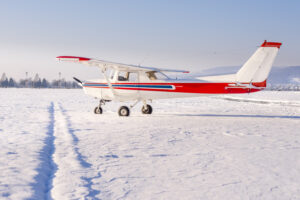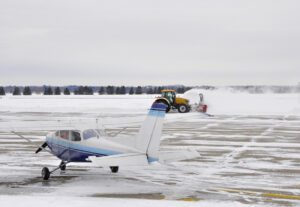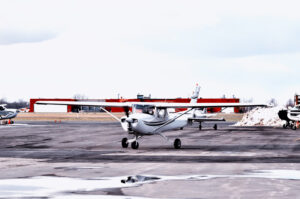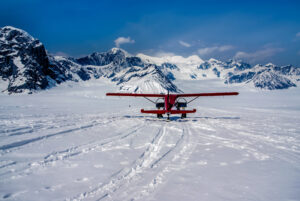 Today is the first day of winter, and with the cooler temperatures come new challenges for pilots across the country. Regardless of whether you spend the winter months flying in sunny Florida or not-so-sunny Alaska, the changing seasons should change how your prepare for your flights. However, flying in winter is not any more dangerous than in any other time of the year as long as pilots continue to use good judgment. Here are a few tips for staying safe while flying in the winter.
Today is the first day of winter, and with the cooler temperatures come new challenges for pilots across the country. Regardless of whether you spend the winter months flying in sunny Florida or not-so-sunny Alaska, the changing seasons should change how your prepare for your flights. However, flying in winter is not any more dangerous than in any other time of the year as long as pilots continue to use good judgment. Here are a few tips for staying safe while flying in the winter.
Preparing for Winter
Although winter varies in intensity from year to year, you can say with some certainty that the weather is going to cool off and that by December and January you will be experiencing whatever winter conditions are common for the area where you live. Just as pilots are always thinking ahead, it is a good idea to prepare for winter beforehand.
A good place to start is to check if your aircraft manufacturer provides a winterization kit. This could include things like covers to partially close to air inlets or an oil-cooler cover.
It is extremely important that you use the correct weight of oil for winter operations. The same oil used for the summer months may not cut it in the winter. If you are not sure, look up the proper weight oil in your aircraft manual.
If your airplane has wheel fairings installed, consider removing them for the winter. Water or slush can get caught inside the fairing and freeze after takeoff. This could result in a nasty surprise if your wheels lock up on landing! It is safer to lose the few knots of extra airspeed the fairings provide and be sure that your landing gear will be free of ice.
Other items that are good to check before the cold temperatures hit include batteries, control cables, heating systems, and tire pressure. In addition, if you don’t have an emergency survival kit onboard your aircraft, add one. This can be a literal life saver if something unexpected happens and you find yourself stranded in the cold.
It can be easy to feel tempted to hurry things up in a desire to get out of the cold. However, it is more important than ever to slow down and be extremely thorough when preparing to fly in the cold. This begins with pre-flight preparation and applies to every phase of the flight.
As with every flight, it is a good idea to consider alternatives in case the trip cannot be completed as planned. If you are traveling to a meeting, explain that you may have to cancel if weather deteriorates. If it is a priority to make the trip, consider leaving a day earlier, driving, or even flying commercially when the weather is marginal. By thinking about these possibilities ahead of time, you relieve yourself of the pressure to continue a flight into poor weather conditions just so you can arrive by a certain deadline. Never bust your personal minimums!
As always, weather can have a great impact on the outcome of your flight. When you are planning, try to develop a complete understanding of the weather patterns along your route of flight. Conditions can change rapidly, but by taking the time to plan for alternatives, you can make many of the hard decisions while you are still on the ground, instead of when you encounter a situation in flight.
Do not rush the pre-flight inspection. During the pre-flight inspection, some items will need extra attention in the winter. Many aircraft utilize an exhaust shroud to provide cabin heat. Carefully inspect the shroud and the heating system to ensure there are no signs of exhaust leaking into the cabin air. Pitot tubes, static ports, fuel vents, and fuel sump drains should all be inspected for ice blockages. If you are not able to drain fuel from the fuel sump, this could indicate ice has formed and is blocking the sump. In this case, the airplane should be moved to a heated hangar to allow the ice to melt and water to be drained from the fuel tanks.
Before you finish your pre-flight, make sure that all snow, frost, or ice has been completely removed from the wings. Even a small amount of frost on the wing can significantly degrade the lift produced, possibly to the point where takeoff is impossible. Do not assume frost or snow will blow off during taxi or takeoff. A little time in a heated hangar will go a long way in helping to remove frost from the airframe, but be sure to dry the airplane before moving it into the cold where the water could refreeze.
Take things slowly during ground operations. Use low RPM settings and little prime when starting the engine. This will decrease engine wear and the risk of a fire on startup. Immediately check the oil pressure and temperature after start and allow the engine to warm up before taxiing.
When you are ready to taxi, move slowly, avoid sharp turns, and don’t stop abruptly. Directional control can be lost quickly due to icy taxiways. The wind plays a bigger role when taxiing on slick surfaces. Use the correct crosswind inputs and aerodynamic control to maintain your desired track. During the run-up, keep your eyes outside to see if you are moving because your brakes may not be effective if the run-up area is iced over.
As you begin your takeoff run, take a final look at the engine gauges and increase the throttle slowly. Continue to hold in crosswind correction as needed and avoid using the brakes for directional control. If you taxi through or takeoff from a slushy runway and your airplane has retractable gear, delay retracting the landing gear to let any slush blow out of the wheel wells.
Continue to monitor the engine gauges as you transition to cruise flight. Power settings may have to be adjusted due to the increased output from the cold, dense air. Be on the lookout for issues such as carburetor icing, which can still form at cruise power settings depending on the temperature and humidity. A smell of exhaust in the cockpit could indicate the presence of carbon monoxide. Turn off the cabin heat and open a fresh air vent to prevent carbon monoxide poisoning.
Higher power settings may be required during descent to maintain acceptable engine temperatures. Be on the lookout for carburetor icing and apply carb heat if needed. Continue to stay aware of your surroundings throughout the landing roll out and taxi to park. During the landing, use the brakes sparingly and let the airplane slow down on its own, especially since black ice, which is difficult to see, may have formed. Avoid running over snowbanks and try to remain in the cleared areas of the runway and taxiway.
After landing, secure the aircraft in a way that will make your next preflight easier. Fuel should be refilled after every flight to prevent the possibility of moisture condensing and freezing inside the tanks. If possible, park the plane in a hangar overnight. This will help keep the plane warm and prevent frost from forming. If you have to park outside, consider using an insulated engine cover or wing covers and plug the engine inlets to retain as much heat as possible.
Are you a rusty pilot? The Gleim Pilot Refresher Course can help you increase your knowledge and abilities to fly safely! If you need to brush up on your IFR skills, consider the Instrument Pilot Refresher Course.
Staying safe during winter flight operations does not have to be complicated. Slow down, stay vigilant, and make good decisions because the winter season can produce some of the most breathtaking and memorable flights. Enjoy the views and be sure to tag @gleimaviation with your favorite winter flying pictures on Facebook, Instagram, or Twitter!
Written by Karl Winters, Gleim Aviation Editor and Instructor




